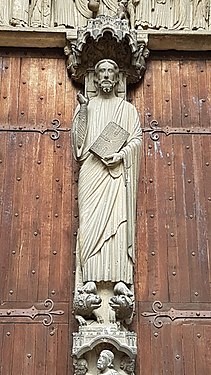The portals and their sculptures

The portals and their sculptures
The portals of Chartres Cathedral are remarkable for their artistry and symbolism:
Three Main Portals: The cathedral features three grand portals: one leading into the nave from the west and the transepts from the north and south.
Sculptural Decoration: These portals are adorned with intricate sculptures depicting biblical stories and theological concepts, accessible to both the clergy and laypeople.
Themes of the West Facade Portals: Each west façade portal, created between 1145 and 1155, represents a different aspect of Christ’s role: the right portal symbolizes his earthly Incarnation, the left his Ascension or pre-Incarnation existence, and the center his Second Coming.
Quality of Sculpture: The statuary on the Chartres portals is regarded as some of the finest Gothic sculpture in existence.
The West or Royal Portal
The West or Royal Portal of Chartres Cathedral, surviving the 1194 fire, is notable for its theological symbolism and architectural harmony:
Central Tympanum: This features Christ seated on a throne, symbolizing his majesty and divine authority. He is encircled by the symbols of the four Evangelists, each representing a different aspect of Christ’s life and teachings.
Jambs of the Central Doorway: These are adorned with statues representing figures from the Old Testament. This inclusion emphasizes the continuity between the Old and New Testaments, underscoring the cathedral’s role in imparting theological teachings.
West Portal, Left Door Tympanum: Illustrates Christ on a cloud, flanked by angels, above representations of the labors of the months and signs of the Zodiac. This reflects the medieval worldview that linked the celestial, the temporal, and the divine.
Thematic Focus of Portals: Each portal has a distinct focus – the right on Christ’s incarnation, the left possibly on his Ascension or Second Coming, and the central on his Second Coming, as described in the Book of Revelation. This arrangement creates a comprehensive narrative of Christian salvation history.
Sculptural Elements: The archivolts and other sculptural decorations include sophisticated theological themes, such as personifications of the Seven Liberal Arts, the 24 Elders of the Apocalypse, and signs of the Zodiac.
Unified Façade Design: The facade’s coherence is achieved through its sculptural elements, particularly the jamb statues and the extensive frieze, which narrate the lives of the Virgin Mary and Christ. The proportional harmony of the portals further adds to this unity.
Architectural Proportions and Ratio: The specific ratio of the portal widths contributes to the overall aesthetic balance and is a testament to the cathedral builders’ understanding of mathematical principles in design.
North transept portals
The North transept portals of Chartres Cathedral, from the 13th century, feature rich iconography emphasizing the Virgin Mary and Old Testament themes:
Central Portal: Depicts Saint Anne holding the infant Virgin Mary, with the Dormition (death) and Assumption of the Virgin on the lintel, and the Coronation of the Virgin in the tympanum.
New Testament Figures: Includes representations of Simeon, John the Baptist, and Saint Peter.
Old Testament References: Features unidentified characters from the Old Testament.
Iconographic Scheme: The statuary focuses on Old Testament events leading to Christ’s birth, particularly highlighting Mary. Exceptionally, statues of St Modesta and St Potentian are present, linked to the crypt relics.
Portal Imagery:
Left Portal: Annunciation to Mary and Nativity scenes.
Central Portal: Dormition and Assumption of the Virgin, and the Coronation of the Virgin.
Right Portal: King Solomon and Queen of Sheba, Judgment of Solomon.
Additional Carvings: The porches contain carvings of local saints, Old Testament narratives, natural elements, and personifications of the ‘active and contemplative lives’, with detailed depictions of flax preparation, a significant medieval crop.
South Transept Portals
The South transept portals of Chartres Cathedral, added in the 13th century, focus on post-Crucifixion events and Christian martyrs:
- Thematic Focus: The south portal emphasizes the Christian narrative following Christ’s Crucifixion:
– The central bay is dedicated to the Last Judgment and the Apostles, depicting the weighing of souls and Christ showing his wounds.
– The left bay focuses on martyrs, showcasing their lives and sacrifices, including the martyrdom of St Stephen.
– The right bay honors confessor saints, with detailed scenes from the lives of St Nicholas of Bari and St Martin of Tours.
Iconographic Detail:
– Left Portal: The jamb figures here are martyr saints, with the lintel portraying the martyrdom of St Stephen and the tympanum presenting his vision of Christ.
– Central Portal: Features the Apostles as jamb figures, with the lintel illustrating the separation of the blessed and damned, and the tympanum showing Christ with the Virgin and St John.
– Right Portal: Dedicated to confessor saints, depicting various scenes from their lives in the lintel and tympanum, and life of St Giles in the lower archivolt.
Architectural and Sculptural Decorations: The arches and columns of the porch are lavishly decorated, encompassing a range of themes from laborious activities to celestial signs, virtues, and vices. The porch’s pinnacles feature statues of kings, including King David, symbolizing Christ’s lineage and the connection between the Old and New Testaments
Angels and Monsters
The sculptures of Chartres Cathedral include both divine figures and monstrous representations:
- Angels: Symbolic and serene, such as the angel with a sundial on the south façade, representing celestial and divine elements.
- Gargoyles and Chimeras: These figures, found on towers and facades, serve dual purposes. Gargoyles, like those on the north tower, are functional as rain spouts, while chimeras and other monstrous sculptures, like those on the south tower, are allegorical, representing the consequences of ignoring Biblical teachings.
- Representations of Evil: On the south portal, sculptures of monsters and devils depict the temptation of Christians and the horrors of hell, serving as a moral and religious warning to the faithful.
restore and preserve the cathedral of Notre-Dame de Chartres
Your contributions are tax deductible in the United States to the extent allowed by law.









